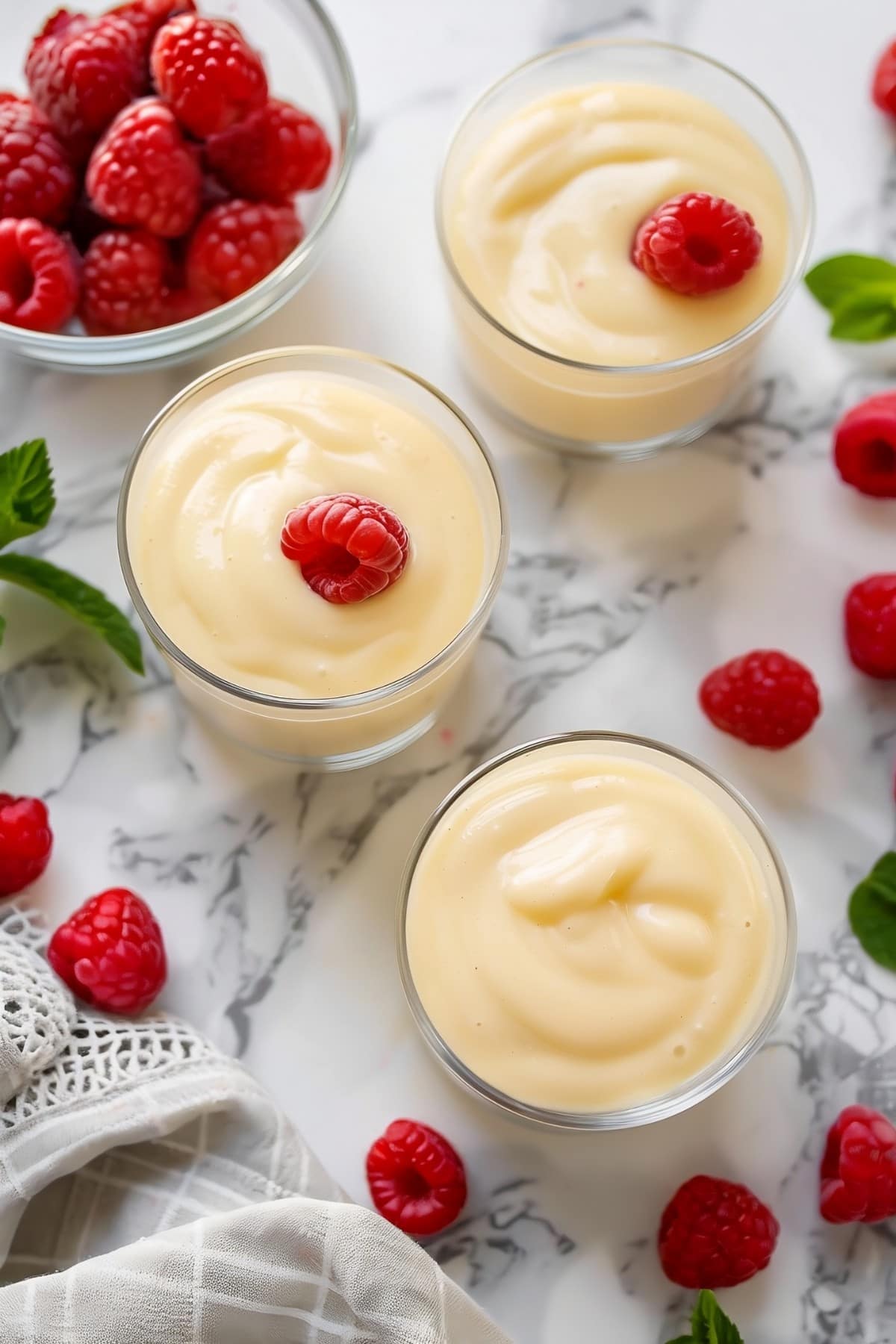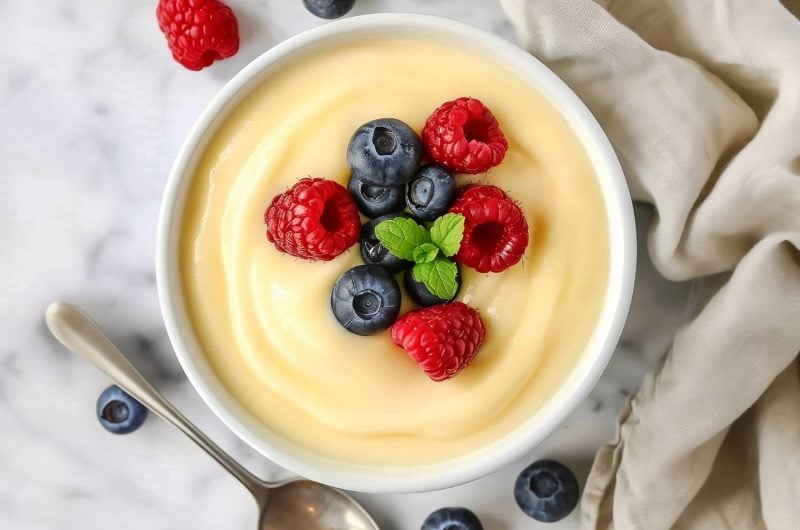This homemade vanilla custard recipe is so delicious, you’ll want to eat it with a spoon. (At least, that’s what I did!)
The combination of milk and cream makes it rich but not too heavy. And using real vanilla beans guarantees the most incredible sweetness.
It’s tasty served warm on top of cakes and pie, cold in a trifle, or as a cake filling. Either way, it’s a must-make!

Why You’ll Love This Vanilla Custard
Vanilla custard is a labor of love, offering silky, dreamy, vanilla-infused bliss in every spoonful.
Here’s why you need to make it:
Timeless Treat: Vanilla custard is a classic dessert that’s been enjoyed for generations. It’s a comforting, nostalgic treat that appeals to all ages.
Comforting Indulgence: The warm, sweet aroma and flavor of vanilla custard evoke feelings of comfort, nostalgia, and indulgence – it’s like a hug in a bowl.
Versatile Dessert: Enjoy it on its own, use it as a filling for cakes, tarts, and pastries, or serve it as a sauce over fruit or other desserts.
Ingredients
Whether you serve it warm from the stovetop or chilled from the fridge, there’s no wrong way to enjoy vanilla custard.
It’s one of those simple pleasures that never fails to delight.
Here’s what you’ll need to make it:
- Whole Milk: Provides a rich, creamy base. The high-fat content helps create a smooth, luxurious texture, so be sure to use whole milk.
- Heavy Cream: Another layer of richness that also creates a silky mouthfeel.
- Granulated Sugar: Sweetens the custard and helps create a balanced flavor. Feel free to swap in brown sugar if you want a more caramel-like taste. Just know it will make the color more brown than yellow.
- Salt: Enhances the vanilla flavor and balances the sweetness.
- Vanilla Bean*: Steeping the bean infuses the custard with pure, intense vanilla flavor, elevating it to gourmet status.
- Egg Yolks: To thicken and emulsify the custard.
- Cornstarch: Helps thicken and stabilize the custard.
*Vanilla Paste. If you don’t have beans, vanilla paste is the next best thing.
With the brand I use, 1 vanilla bean is equal to 1 tablespoon of vanilla paste. But that can vary depending on the brand and type of paste.
For example:
- Dr. Oetker Madagascan Vanilla Bean Paste states: 1 teaspoon = 1 vanilla bean.
- Nielsen Massey Vanilla Bean Paste (the brand I use) states: 1 tablespoon vanilla bean paste = 1 tablespoon vanilla extract = 1 whole vanilla bean = 1 tablespoon vanilla powder
If you’re unsure of how much to use, check the package for instructions. Start with 1 teaspoon and add more to taste.

How to Make Vanilla Custard
Unlike instant powder, there are a few key techniques for making custard at home.
You’ll steep real vanilla beans in milk, temper the eggs, and strain the final custard to achieve the silkiest, smoothest, most luxurious texture and flavor.
But I promise, it’s nothing you can’t handle! Here are the basic steps:
1. STEEP. Split the vanilla bean and place it in a saucepan with the milk, cream, sugar, and salt. Simmer and stir for about 15 minutes.
2. TEMPER. Whisk the yolks with the cornstarch, then temper them with the hot milk mixture.
3. COOK. Add the tempered eggs to the milk and cook, stirring constantly, until thick. Mix in the butter last until glossy.
4. STRAIN. Pour the thick custard through a fine mesh sieve into a heat-proof bowl or container. Cover it with plastic and press it to the surface.
5. COOL. Let the custard cool to room temperature before transferring to the fridge.

Tips For the Best Vanilla Custard
There’s something so comforting and nostalgic about the smooth, creamy texture and rich vanilla flavor of this custard.
But if you’ve never made it before, check out these tips and tricks before you get started:
- Have everything ready. Measure the ingredients and have the sieve and bowl prepared for when the custard is done.
- Stir/whisk constantly. Keep the milk moving to prevent scalding. Then, whisk the eggs and custard constantly to avoid scrambled eggs and lumps.
- Keep it smooth. After straining, press plastic wrap directly onto the surface of the custard before chilling. Otherwise, it will form a thick ‘skin’ on top.
- Flavor options. To vary the flavor, experiment with different extracts, such as almond or coconut, liqueurs like Grand Marnier, or spices like nutmeg. You can even add chocolate chips to the hot custard and whisk until smooth.
- Serving suggestions. Enjoy custard chilled with fresh berries, as a cake or fruit pie filling, layered in trifles or banana pudding, or warm drizzled over desserts like apple crisp.
- Frozen custard. Transfer the chilled, set custard to an ice cream maker and churn until smooth.
What Is Tempering?
Tempering eggs is a technique used when making custards, sauces, and soups.
In such dishes, you need to slowly raise the temperature of the eggs so they mix smoothly into the hot liquid.
This thickens the dish without cooking the eggs in solid pieces.
Here’s how to temper eggs:
1. Heat the liquid (milk, cream, broth, etc.) in a saucepan until simmering. Do not let it boil.
2. Crack the eggs into a bowl and whisk until smooth. If the recipe calls for it, whisk in sugar or cornstarch as well – but only right before adding the hot milk, as it can crystallize as it sits.
3. Very slowly drizzle a ladleful of the hot liquid into the eggs while vigorously whisking constantly. Place the bowl on a rubber mat or damp paper towel to keep it still.
4. Continue adding the hot liquid to the eggs a little at a time while whisking until the eggs are warm to the touch and the bowl feels hot. About 1 cup should be enough.
5. Slowly pour the tempered egg mixture into the saucepan with the remaining hot liquid, whisking constantly.
6. Continue cooking the mixture over low heat, stirring constantly, until the mixture thickens enough to coat the back of a spoon. Do not allow it to boil.
7. Strain the thickened mix through a fine mesh sieve to remove lumps. Chill with plastic pressed onto the surface – it will thicken more as it cools.
The key point is to combine the hot and cold mixtures very gradually while whisking vigorously.
This controlled heating prevents the egg proteins from coagulating and curdling before they are dispersed throughout the liquid.

How to Store
Vanilla custard is a great make-ahead recipe, as it needs to chill in order to set. However, you can also serve it warm, straight from the pan, or reheated.
Either way, here’s how to store it:
To Store: Transfer vanilla custard to an airtight container and press a layer of plastic wrap directly onto the surface. Keep in the fridge for 3-5 days.
To Reheat: Microwave small portions in 15-second intervals, stirring between each spin, until hot. Or reheat larger portions over a double boiler, stirring constantly, until warm.
Note: I don’t recommend freezing vanilla custard as the texture will become grainy and watery when thawed.
How to Serve Vanilla Custard
I love this stuff so much, I lick the bowl clean and eat it right out of the tub!
But it’s a lot more versatile than you think! Here are a few great ways to serve and use homemade vanilla custard:
Pear Crisp
Bourbon Pecan Pie
Croissant Bread Pudding
Banana Pudding Cake
Chocolate Trifle










I read through this recipe few times but could not find any mention of how and when to use the butter, did I miss it somehow or it really isn’t mentioned expect for the ingrediencies list.
Hi Andre!
Thanks for catching that.
The butter goes in right at the end.
I’ve amended the recipe to include this step 🙂
1 Tbsp of vanilla paste was way too much! I think it was supposed to be 1 tsp. Otherwise this worked for is using dairy free milk and cream substitutes!
Hi Koro!
I’ve added a note to the post about this.
With the brand I use (Nielsen Massey), 1 vanilla bean is equal to 1 tablespoon of vanilla paste.
But, you’re right, other brands are more concentrated. So it’s best to double check the package to see what the brand recommends.
Thanks for bringing that to our attention 🙂
How much of vanilla extract can be used?
I have not made this recipe yet, but I did a little digging. It seems as though most similar recipes use a tablespoon of vanilla extract to replace the vanilla bean. Hope that helps!